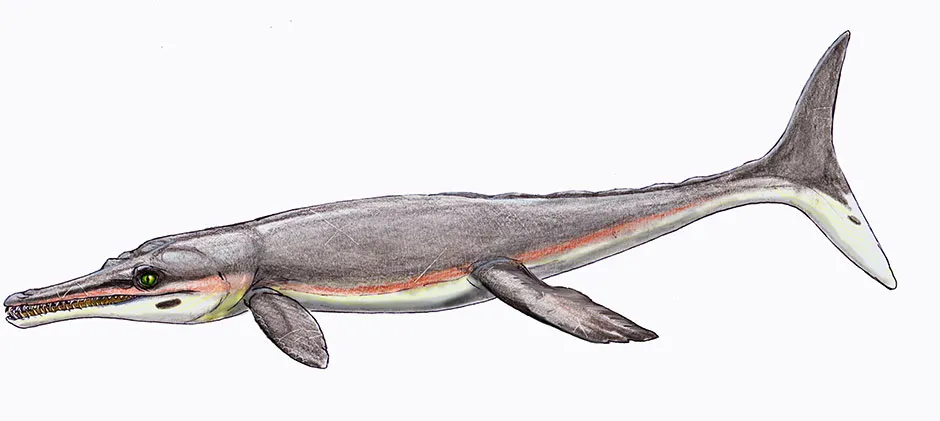Deadly prehistoric crocodiles mimicked the shape and senses of whales and dolphins to dominate Jurassic seas, new research has found.
The extinct crocodiles, Thalattosuchia, evolved from their land-living ancestors to become fast-swimming predators. Their limbs adapted into flippers, and their bodies streamlined and formed fluked tails to help them move powerfully through the water.
Experts from the University of Edinburgh have also found a part of the inner ear, responsible for balance and equilibrium, adapted as they gradually adjusted to their new ocean home 170 million years ago.
Read more about ancient crocodiles:
- Make it snappy! Crocodile fossil identified after 250 year wait
- Ancient 8-metre crocodile needed extra bones to move around
Paleontologists analysed CAT scans of more than a dozen fossil skulls to examine the vestibular system of the inner ear, which comprises of three looping semicircular canals and helps with balance and spatial awareness.
As Thalattosuchia made their first steps into the water, during a long semi-aquatic phase, their ear canals became markedly fatter and smaller, which made the sensory system less sensitive. This shape is shared by dolphins and whales.
Scientists said this canal shape is better suited to life in the oceans, where buoyancy can hold up an animal, as compared to land, where animals need an excellent sense of balance to cope with gravity and complex landscapes.

A similar change occurred independently in whales.It is thought that each species mimicked each other’s changes during this period of adaptation.
Julia Schwab, a PhD student in the University of Edinburgh’s School of GeoSciences, who led the study, said: “Sensory organs such as the inner ear are key to understand how ancient animals lived.
“We found that marine crocodile relatives have a very unique inner ear shape, similar to other water-living reptiles and today’s whales.”
Experts said the findings also show the crocodiles’ sensory systems evolved in response to their new deep-water environment, rather than driving them into it.
Read more about evolution:
- Here's looking at poo: the weird and wonderful species that look like faeces
- Size matters: narwhals' long tusks help them find a mate
Dr Steve Brusatte, also of the School of GeoSciences and senior author on the study, said: “The ancient aquatic crocs developed unusual inner ears after modifying their skeletons to become better swimmers.
“Whales also changed their ears in a similar way, but did it soon after entering the water. It seems like the crocs and whales took similar but different evolutionary routes from land to water.”
The study, published in Proceedings of the National Academy of Sciences (USA), was supported by a grant from the Leverhulme Trust.
It involved a team of scientists from around the world, including colleagues from the National Museum of Scotland.
Reader Q&A: Why did crocodiles stop evolving?
Asked by: Jamie Malley, By Email
They didn’t. Nothing that’s still alive has stopped evolving. Change continues, and some individuals live while others die. So evolution cannot stop. It’s true that crocodiles haven’t changed much over millions of years, but that’s because they’re so successful at exploiting a niche that hasn’t changed much either.
What is curious about modern crocodiles is that their land-based ancestors, that walked on two legs, somehow survived whatever wiped the dinosaurs out about 65 million years ago. Modern crocodiles still have hind legs longer than front legs inherited from them. When they evolved into aquatic creatures they had to avoid breathing water and so evolved a second palate in the roof of the mouth to keep air and water apart.
Crocodiles will probably keep evolving while looking and behaving much the same as long as their niche of warm food-rich waters survives. Otherwise they will have to change to adapt or go extinct as so many other creatures have before them.
Read more: